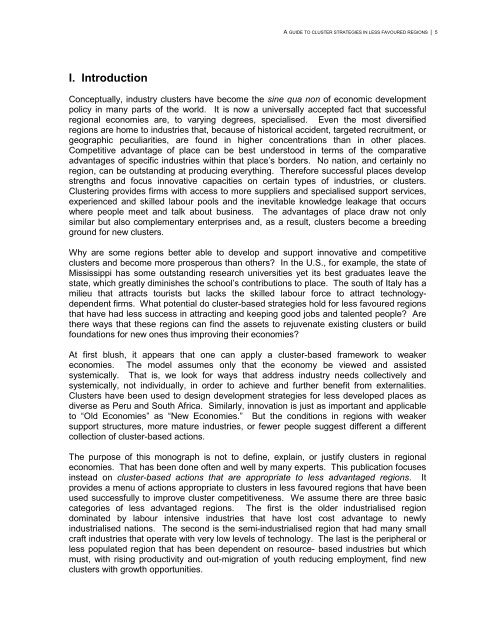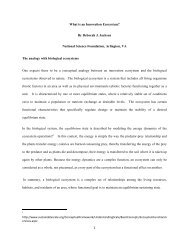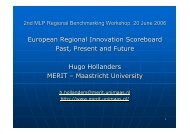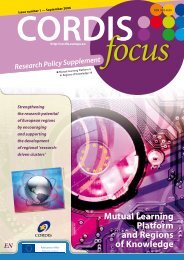Creating smart systems, guide to Cluster strategies in less favoured
Creating smart systems, guide to Cluster strategies in less favoured
Creating smart systems, guide to Cluster strategies in less favoured
You also want an ePaper? Increase the reach of your titles
YUMPU automatically turns print PDFs into web optimized ePapers that Google loves.
A GUIDE TO CLUSTER STRATEGIES IN LESS FAVOURED REGIONS | 5<br />
I. Introduction<br />
Conceptually, <strong>in</strong>dustry clusters have become the s<strong>in</strong>e qua non of economic development<br />
policy <strong>in</strong> many parts of the world. It is now a universally accepted fact that successful<br />
regional economies are, <strong>to</strong> vary<strong>in</strong>g degrees, specialised. Even the most diversified<br />
regions are home <strong>to</strong> <strong>in</strong>dustries that, because of his<strong>to</strong>rical accident, targeted recruitment, or<br />
geographic peculiarities, are found <strong>in</strong> higher concentrations than <strong>in</strong> other places.<br />
Competitive advantage of place can be best unders<strong>to</strong>od <strong>in</strong> terms of the comparative<br />
advantages of specific <strong>in</strong>dustries with<strong>in</strong> that place’s borders. No nation, and certa<strong>in</strong>ly no<br />
region, can be outstand<strong>in</strong>g at produc<strong>in</strong>g everyth<strong>in</strong>g. Therefore successful places develop<br />
strengths and focus <strong>in</strong>novative capacities on certa<strong>in</strong> types of <strong>in</strong>dustries, or clusters.<br />
<strong>Cluster</strong><strong>in</strong>g provides firms with access <strong>to</strong> more suppliers and specialised support services,<br />
experienced and skilled labour pools and the <strong>in</strong>evitable knowledge leakage that occurs<br />
where people meet and talk about bus<strong>in</strong>ess. The advantages of place draw not only<br />
similar but also complementary enterprises and, as a result, clusters become a breed<strong>in</strong>g<br />
ground for new clusters.<br />
Why are some regions better able <strong>to</strong> develop and support <strong>in</strong>novative and competitive<br />
clusters and become more prosperous than others In the U.S., for example, the state of<br />
Mississippi has some outstand<strong>in</strong>g research universities yet its best graduates leave the<br />
state, which greatly dim<strong>in</strong>ishes the school’s contributions <strong>to</strong> place. The south of Italy has a<br />
milieu that attracts <strong>to</strong>urists but lacks the skilled labour force <strong>to</strong> attract technologydependent<br />
firms. What potential do cluster-based <strong>strategies</strong> hold for <strong>less</strong> <strong>favoured</strong> regions<br />
that have had <strong>less</strong> success <strong>in</strong> attract<strong>in</strong>g and keep<strong>in</strong>g good jobs and talented people Are<br />
there ways that these regions can f<strong>in</strong>d the assets <strong>to</strong> rejuvenate exist<strong>in</strong>g clusters or build<br />
foundations for new ones thus improv<strong>in</strong>g their economies<br />
At first blush, it appears that one can apply a cluster-based framework <strong>to</strong> weaker<br />
economies. The model assumes only that the economy be viewed and assisted<br />
systemically. That is, we look for ways that address <strong>in</strong>dustry needs collectively and<br />
systemically, not <strong>in</strong>dividually, <strong>in</strong> order <strong>to</strong> achieve and further benefit from externalities.<br />
<strong>Cluster</strong>s have been used <strong>to</strong> design development <strong>strategies</strong> for <strong>less</strong> developed places as<br />
diverse as Peru and South Africa. Similarly, <strong>in</strong>novation is just as important and applicable<br />
<strong>to</strong> “Old Economies” as “New Economies.” But the conditions <strong>in</strong> regions with weaker<br />
support structures, more mature <strong>in</strong>dustries, or fewer people suggest different a different<br />
collection of cluster-based actions.<br />
The purpose of this monograph is not <strong>to</strong> def<strong>in</strong>e, expla<strong>in</strong>, or justify clusters <strong>in</strong> regional<br />
economies. That has been done often and well by many experts. This publication focuses<br />
<strong>in</strong>stead on cluster-based actions that are appropriate <strong>to</strong> <strong>less</strong> advantaged regions. It<br />
provides a menu of actions appropriate <strong>to</strong> clusters <strong>in</strong> <strong>less</strong> <strong>favoured</strong> regions that have been<br />
used successfully <strong>to</strong> improve cluster competitiveness. We assume there are three basic<br />
categories of <strong>less</strong> advantaged regions. The first is the older <strong>in</strong>dustrialised region<br />
dom<strong>in</strong>ated by labour <strong>in</strong>tensive <strong>in</strong>dustries that have lost cost advantage <strong>to</strong> newly<br />
<strong>in</strong>dustrialised nations. The second is the semi-<strong>in</strong>dustrialised region that had many small<br />
craft <strong>in</strong>dustries that operate with very low levels of technology. The last is the peripheral or<br />
<strong>less</strong> populated region that has been dependent on resource- based <strong>in</strong>dustries but which<br />
must, with ris<strong>in</strong>g productivity and out-migration of youth reduc<strong>in</strong>g employment, f<strong>in</strong>d new<br />
clusters with growth opportunities.
















